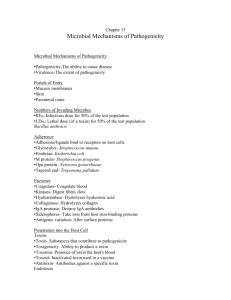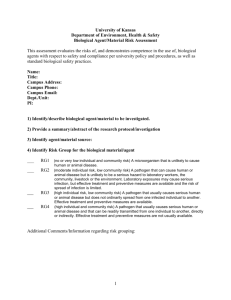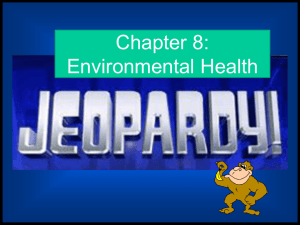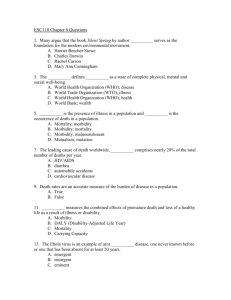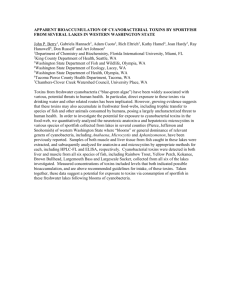Heaven Le A. Roberts ANS 420, 5 March 2015
advertisement
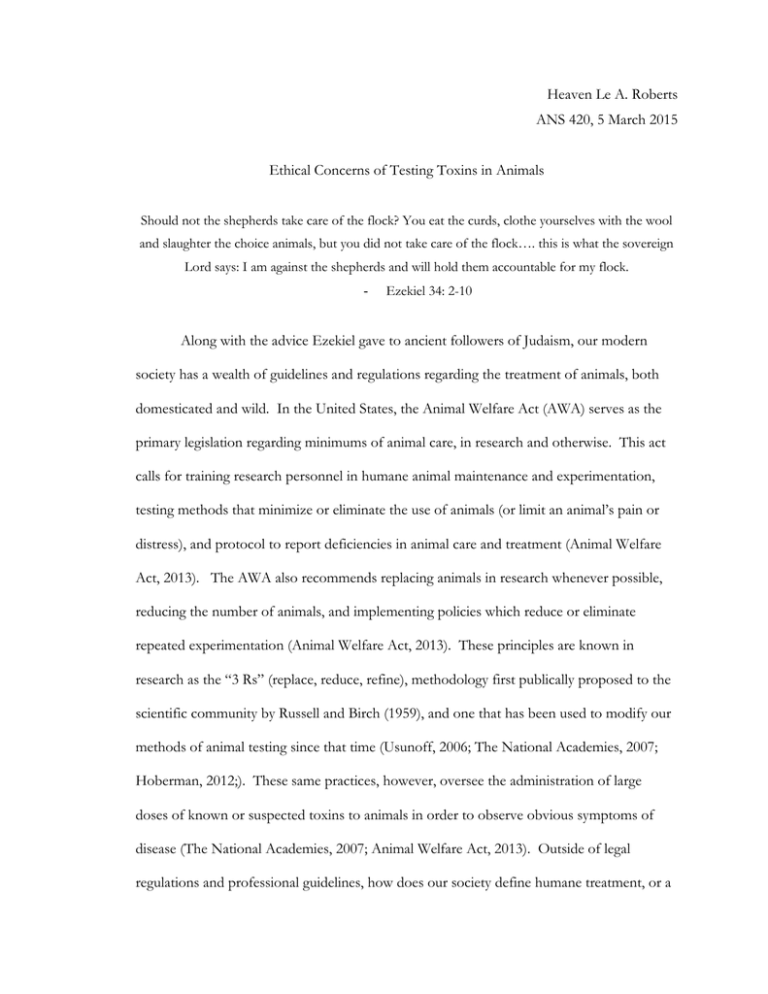
Heaven Le A. Roberts ANS 420, 5 March 2015 Ethical Concerns of Testing Toxins in Animals Should not the shepherds take care of the flock? You eat the curds, clothe yourselves with the wool and slaughter the choice animals, but you did not take care of the flock…. this is what the sovereign Lord says: I am against the shepherds and will hold them accountable for my flock. - Ezekiel 34: 2-10 Along with the advice Ezekiel gave to ancient followers of Judaism, our modern society has a wealth of guidelines and regulations regarding the treatment of animals, both domesticated and wild. In the United States, the Animal Welfare Act (AWA) serves as the primary legislation regarding minimums of animal care, in research and otherwise. This act calls for training research personnel in humane animal maintenance and experimentation, testing methods that minimize or eliminate the use of animals (or limit an animal’s pain or distress), and protocol to report deficiencies in animal care and treatment (Animal Welfare Act, 2013). The AWA also recommends replacing animals in research whenever possible, reducing the number of animals, and implementing policies which reduce or eliminate repeated experimentation (Animal Welfare Act, 2013). These principles are known in research as the “3 Rs” (replace, reduce, refine), methodology first publically proposed to the scientific community by Russell and Birch (1959), and one that has been used to modify our methods of animal testing since that time (Usunoff, 2006; The National Academies, 2007; Hoberman, 2012;). These same practices, however, oversee the administration of large doses of known or suspected toxins to animals in order to observe obvious symptoms of disease (The National Academies, 2007; Animal Welfare Act, 2013). Outside of legal regulations and professional guidelines, how does our society define humane treatment, or a lack thereof? Is it humane to knowingly cause an animal pain, distress or suffering? Is a veterinarian breaking their oath by knowingly causing reduced welfare and increased pain, while offering no relief from suffering? If our society would define these practices as inhumane or unethical, then we would define the testing of toxins on animals in laboratories across the world as such. The question of our limits on the term “welfare” continue to cause heated debate between and amongst researchers, the public, animal rights groups, animal welfare advocates and policy makers. Social and religious values may make it difficult for some to accept the mistreatment of animals, even if that mistreatment may lead to medical advances for humans and other species (Bressman, 2001). These same values may lead consumers to consider toxin testing on animals, by definition, as inhumane mistreatment, and ethically unacceptable (Bressman, 2001; PETA, 2015). In addition, cost has become prohibitive for those funding these experiments, and therefore alternatives are being developed in the scientific community for both moral and economic reasons (Weil and Scala, 1971; Institute for Laboratory Animal Research, 2004; The National Academies, 2007; Mitjans et al., 2008). Many consumers, animal rights activists, and even researchers question if valid results can be obtained through the use of animal test subjects (Institute for Laboratory Animal Research, 2004; The National Academies, 2007). In light of emerging alternatives, the welfare of the animal, the relevance of the tests, and economical and societal benefits and drawbacks, is testing of known or suspected toxins on animals ethically justifiable? Animal welfare during toxin testing is the crux of the debate. Broom defines welfare as an individual’s ability to cope with its environment (2011), yet in toxicology research, the aim of the experiment is often to inhibit that ability, thus reducing welfare (Daston and McNamee, 2005; The National Academies, 2007; Menache and Nastrucci, 2012). Preference Roberts 2 tests, when appropriately applied, preference testing can be used to evaluate and quantify welfare (Broom, 2011), but here the testing of natural toxins offers another dilemma: when animals are offered a choice of a toxic substance and a non-toxic substance, if they would encounter the same in nature, should we allow them to consume the more toxic option, while we are aware of the consequences? Conover and Messmer (1996) found that Zebra Finches actually preferred endophyte infected (high alkaloid) fescue seeds over non-infected seeds (both of which would simulate a natural diet for these birds) for the first several months of treatment, even though these seeds would have toxic effects on them during that time. Not until several months had passed did the finches begin to show preference for the non-toxic food option (Conover and Messmer, 1996). The Society of Toxicology argues that research involving animal testing is necessary to protect human and environmental health, and the understanding of a toxin within a full living animal is just one of the many reasons for this justification (2006). While the Food and Drug Administration encourages researchers to seek alternatives, they also argue that there are many situations in which non-animal testing is still not a valid option (2014). Alternatives such as cell cultures can be very useful, but can also provide unreliable results – showing a lack of toxicity where one is indeed present (van Vliet, 2011). Biotransformation of toxins in the liver is extremely important to understanding how toxins are metabolized and moved within the body, and are frequently tested using the animal model (Leeson et al., 1995). Liver cell cultures have been developed to simulate liver function within a living animal, yet for reasons not yet fully understood, these cells may spontaneously lose their functionality, sometimes as soon as only a few days after being placed in culture (van Vliet, 2011). An animal model can continue to show toxic reactions after months or even years, Roberts 3 and over multiple generations, giving us valuable information on how to avoid, prevent and treat these toxins (Scanes and McNabb, 2003; Dorne and Fink-Gremmels, 2013). Historically, animal testing has made numerous advances in human medicine possible (Ueno, 1984; Department of Defense, 2000; Kadis, 2013). Perhaps one of the most commonly studied groups of toxins is the mycotoxins – those produced by various fungi. One such group, trichothecenes, is known as the most potent small molecule inhibitor of protein synthesis in the eukaryotic cell (Lesson et al., 1995), with a long history of causing human illness and death (Kadis, 2013). This potent toxin is found in cereal grains across the globe, and infects as much as 100% of the cereal grain plants in a given region (Loiveke et al., 2003). Trichothecene's toxic effect on humans, alimentary toxic aleukia, includes symptoms such as bleeding from the nose, throat and gums, angina resulting in necrosis of limbs, extreme leukopenia and depletion of bone marrow, agranulocytosis, and eventually sepsis (Kadis, 2013). These conditions result in very high mortality for those consuming infected grains, up to 60%, and have killed whole families or even entire villages (Kadis, 2013). Previous attempts to isolate the cause of ATA were unsuccessful, resulting in multiple misdiagnosis, and it was not until extensive tests on animals were performed (following an epidemic outbreak of the toxin following long winters in post- World War II Russia and Siberia) that preventative measures to avoid the toxicity were established (Kadis, 2013). Further studies on laboratory mice isolated T-2 (and other macrocyclic trichothecenes) as especially toxic (Ueno, 1984). T-2 has been rumored as the cause of the so-called "yellow rain" biological warfare attacks, and the Department of Defense continues to use animals for toxin testing, which the DOD feels benefits the military and civilian communities through the development of biosensors and toxin identification tools (2000) that may prevent bioterrorism or chemical warfare. Roberts 4 Ergot alkaloids, also highly researched in the animal model, can cause vasoconstriction resulting in gangrenous limb loss (accompanied by severe pain), overheating, low blood prolactin levels (leading to multiple physiological changes), spontaneous abortion, convulsions, hallucinations and other mental disorders (Woolf, 2000). Ergotism’s ancient association with cereal grains may explain the “gods” seen in ancient Greece (where a purple drink made from grains was consumed, which would be explained by ergot’s purple color in water), and is the source of “St. Anthony’s Fire”, to which unnumbered Europeans lost their limbs, and their lives (Hudler, 2000). Witchcraft trials of the 17th, 18th and 19th centuries can in many cases also be attributed to ergot alkaloid poisoning (Hudler, 2000; Torbjorn, 2003), as can many of the great rock and roll hits of the 1960s and 1970s. Knowledge gained from animal (and human trials, in the case of one ergot alkaloid – LSD) has moved our understanding of these extremely common toxins from witchcraft to valuable components of prenatal care, neurological pharmaceuticals, pain killers, HIV/AIDS medication and much, much more (Leesen et al., 1995; Hudler, 2000; Torbjorn, 2003; Steinmann and Ganzera, 2011; Dorne and Fink-Gremmels, 2013). These types of toxins – those that provide valuable medical and scientific knowledge after studying their effects on the animal model – are why even in the case of an animal’s suffering, many researchers and consumers still feel that animal testing of toxins is acceptable (Department of Defense, 2000; Scanes and McNabb, 2003; The National Academies, 2007; BIS, 2012). One of the arguments against animal testing, that animals are exposed to various environmental variables, is also one of the strongest arguments for animal testing. Like humans, animals undergo exposure to a number of low dose environmental toxins and conditions throughout their life, which makes them even more comparable to a human than a clinically controlled cell culture, even if that culture is of human cells. In addition, the Roberts 5 physiology of the complete animal must be taken into account – and differences between test subjects may warrant a reversal of the “3 Rs”. In the case of approving drugs previously approved for adult human use for pediatric applications, the juvenile animal may not be replaceable with adult humans, or even adult animals, because of physiological differences between adults and juveniles (Hoberman, 2012). Testing of toxins on multiple species, and more animals within those species, may also result in far more reliable data (Bhardwaj and Gupta, 2012) that may ultimately lead to an overall reduction in future in vivo testing. When testing toxins in multiple species, a response in one but not both (or all three, four, etc.) indicates that the response may not be found in humans, and thus, further animal testing may not be necessarily beneficial (Bhardwaj and Gupta, 2012). In the U.S. and abroad, consumer safety standards currently mandate the use of animal testing to predict and prevent toxic responses in the human population (Department of Defense, 2000; The National Academies, 2007; Humane Society of the United States, 2013). Laboratory animal testing has also helped us understand the implications of environmental and agricultural toxins (such as DDT) for wildlife and the ecosystem, and to treat or prevent future cases of toxicosis in the natural world (Scanes and McNabb, 2003; Campbell-Palmer, 2011). This still leaves the debate: is it ethical to cause the suffering of one animal for the benefit of another, even if that “other” is a human? Animal rights activists and consumers stand behind their primary concerns: the inherent risks of toxin tests are taken on by the test subjects without their consent, results may not be applicable to humans, and animal models in these tests may be unnecessary to gain reliable results. The objections to these tests include moral, religious, financial and medical reasons, thus the number of animal tests has declined in the last thirty years (Usunoff, 2006). Our new understanding of the physiological ability of animals to Roberts 6 experience pain and suffering (Usunoff, 2006) has increased the public’s concern with testing toxins, especially cosmetic toxins that may yield no medical benefit (BIS, 2012). Public reasoning, from a religious (such as Ezekiel) and practical (economical, necessity of the research) origin, has also been a part of that push (BIS, 2012), but many animal rights groups feel that no amount of human medical advancements are worth the suffering such animals undergo – and that recent legislation is not enough (Anti-Vivesection Coalition, 2014). The Humane Society of the United States has expressed concern that even in light of stricter legislation in this country, animal testing is still required by the EPA for potential toxins such as pesticides – where as many as 10,000 dogs, rodents, birds and other animals may be required to register a single product (2013). In addition to the moral conflict of inflicting pain on these animals, there is also pushback from the scientific community to end or reduce in vivo research, for scientific and economic reasons. The Institute for Laboratory Animal Research (2004) found several science-based problems with animal testing: Clinical trials typically test a homogenous group of animals treated with a high dose of a potential toxin; the relevance of these tests to the heterogeneous human population exposed to very low doses may be questionable. Such tests are expensive and time consuming. Results may be difficult to observe during different life stages and with combinations of other environmental factors, and may provide little information on the modes and mechanisms of action. Use of alternatives such as cells in culture is a more economically, and potentially ethically, viable option once the pathways of tissue development are determined. For many years, animal testing has had decreasing public support. Roberts 7 One of these points in particular – the cost of animal testing – has become a major concern for many companies, and a strong arguing point for any group against these (The National Academies, 2007). The Humane Society International reports that in testing certain carcinogens for cancer risk may cost as much as $700,000 in a multi-generational laboratory animal test, and only $22,000 with an in vitro embryo model; and that phototoxicity tests in live animals may cost as much as $11,500 while an in vitro alternative costs only $1,300. These rising costs are pushing many companies to pursue alternatives to animal testing that satisfy economic concerns, while also addressing our society’s changing moral standards (The National Academies, 2007). Economical costs are not the only concern for humans involved in animal toxicity testing. In Good Laboratory Practice Standards (1990), US Government advises researchers to treat animals only if it will not interfere with the study. The Animal Welfare Act (2013) offers multiple exemptions for animals used in research settings, allowing the pain and even long-term suffering of these animals where such conditions would not normally be permissible. While the legal guidelines may allow for these experiments, the veterinarians overseeing these tests must recognize and accept that they may no longer be protecting the health of the test subject, especially while testing known toxins and looking for a negative response – or even recording the method(s) of fatality while poisoning animals to the point of death. More frequent patient euthanasia, such as that found in toxicology testing, has been shown to contribute to work stress, depression, and even suicidal thoughts in practicing veterinarians (Platt et al., 2012). Veterinarians in the U.K. have a suicide rate a full four times that of the general population, possibly due, at least in part, to this high rate of patient euthanasia (Bartram et al., 2008). Animal euthanasia in research can also be particularly upsetting to non-veterinarian clinical staff, those that care for the animals on a Roberts 8 day-to-day basis, as these staff are often encouraged to develop relationships with the animals to alleviate stress and anxiety during testing procedures (Rohlf and Bennett, 2005). Animal research settings can be particularly harmful to the human caregivers when otherwise healthy animals are euthanized during or following testing procedures, either as part of data collection or as a method of disposal at the end of an experiment (Rohlf and Bennett, 2005). These psychological and emotional consequences for clinical staff give credit to a scientific community seeking to eliminate, or at least drastically reduce, animal testing. In many cases, testing on animals may be costly, and unnecessary (Institute for Laboratory Animal Research, 2004). The Draize test, used in ocular toxin testing for the past sixty years, has long been criticized - not only for the effects on the animals, but for its subjective scoring system, great variability among individual animals' response to the test, application to human health, and economical cost (Mitjans et al., 2008; Weil and Scala, 1971). Cell-based, human hemoglobin denaturation, and multiple other in vitro methods have been developed to replace live animal use in eye toxicant testing, which have been shown to be faster, more accurate, and less expensive (Cho et al., 2012; Mitjans et al., 2008; Verstraelena et al., 2013). The fight to eliminate the use of the Draize test has been pushed by not only the animal rights community, but also by the scientific community since as early as the 1980s (Holden, 1988). The “LD50”, a test in which a toxic substance is applied until 50% of the research animals die from acute exposure, is another hotly debated research model contested within the scientific community (Abbot, 2005). Still, by 2005 the “LD50” still accounts for one third of worldwide animal tests (Abbot, 2005). Advancements have been made in the scientific community to replace live animals in toxin tests, but the process is encumbered by multiple hurdles yet to be overcome. Roberts 9 Replacing live animals with in vitro tests has been a slow and laborious process, as international governments are hesitant to eliminate animal testing completely for fear of human toxic response where an in vitro test showed no response (Abbot, 2005). In vivo tests have become the gold standard against which all new testing technologies are compared to, even if those in vivo tests have been shown to be inaccurate (Daston and McNamee, 2005). Regulations still require live animal testing before approval of suspected toxins in many countries, with consumer fears continuing to drive that policy (Daston and McNamee, 2005; Menache and Nastrucci, 2012). Still, there has been a shift in the research community towards replacing higher order animals with lower order test subjects, reducing the overall numbers of animals used, and implementing non-animal testing methods as a whole (The National Academies, 2007). While in vitro tests may not be a complete replacement for animal testing of toxins, many offer highly promising results that can drastically reduce or eliminate live animals from such tests (Department of Defense, 2000; Verstraelena et al., 2013). In addition to replacement, the number of animals used in toxin testing has been on the decline: the number of animal tests legally required in the European Union has fallen from 150 per drug in the 1970s to eight in 2002 (Abbott, 2005). While these changes may be pushed by more than ethical concerns, the reduction in the use of animals in toxin testing is promising to those that have morally opposed this practice for many years. Animal testing has offered us great insight into the world of toxins: the mode of action, the body’s response, and short and long-term consequences to exposure, both acute and chronic. Changing social, economic and scientific viewpoints are pushing the use of live animals in toxicology research aside for in vitro alternatives, and live animal toxicology research may one day be, for better or worse, a thing of the past. Word Count: 3,105 Roberts 10 Literature Cited Abbott, A. 2005. Animal testing: More than a cosmetic change. Nature. 7065: 144. Bhardwaj, S., and D. Gupta. 2012. Study of acute, sub acute and chronic toxicity test. International Journal of Advanced Research in Pharmaceutical & Bio Sciences. 1: 103. BIS. 2012. Views on the use of animals in scientific research. Dept. for Business, Innovation and Skills. Ipsos, Paris, France. Bressman, L. 2001. Accommodation and equal liberty. William and Mary Law Review. 42: 1007. Broom, D. 2011. A history of animal welfare science. Acta Biotheor. 59: 121-137. Campbell-Palmer, R. 2011. The importance of chemical communication studies to mammalian conservation biology: A review. Biol. Conservation 7: 1919-1930. Cho, S., S. An, E. Lee, K. Shin, J. Cho, and T. Lee. 2012. A new cell-based method for assessing the eye irritation potential of chemicals: An alternative to the Draize test. Toxicol. Lett. 212: 198-204. Conover, M., and T. Messmer. 1996. Consequences for captive zebra finches of consuming tall fescue seeds infected with the endophytic fungus Acremonium coenophialum. Auk. 113:492-495. Dorne, J., and J. Fink-Gremmels. 2013. Human and animal health risk assessments of chemicals in the food chain: Comparative aspects and future perspectives. Toxicol. Appl. Pharmacol. 3: 187-195. Daston, G., and P. McNamee. 2005. Alternatives to toxicity testing in animals: Challenges and opportunities. Environ. Health Perspect. 113: 6. Good Laboratory Practice Standards, 40 C.F.R. § 792 (2015). Holden, C. 1988. Much work but slow going on alternatives to Draize test. Science. 242: 185. Hawkins, P. 2014. Progress in assessing animal welfare in relation to new legislation: Opportunities for behavioural researchers. J. Neurosci. Methods. 234: 135-138. Hoberman, A. 2012. Pediatric non-clinical drug testing principles, requirements, and practice. Wiley, Hoboken, NJ. Hudler, G. 2000. Magical mushrooms, mischievous moulds. Princeton University Press, Princeton, New Jersey. Roberts 11 Institute for Laboratory Animal Research. Committee to Update Science, Medicine, and Animals. 2004. Science, medicine, and animals. National Academies Press, Washington, DC. Kadis, S. 2013. Algal and fungal toxins a comprehensive treatise. Elsevier Science, Burlington, Massachusetts. Loiveke, H., H. Laitamm, and R. Sarand. 2003. Fusarium fungi as potential toxicants on cereals and grain feed grown in Estonia during 1973-2001. Agronomy Research. 1: 185-196. Leeson, S., G. Diaz, and J. Summers. 1995. Poultry metabolic disorders and mycotoxins. University Books, Guelph, Ontario, Canada. p. 190-226. Menache, A., and C. Nastrucci. 2012. REACH, animal testing, and the precautionary principle. Medicolegal and Bioethics. 2: 13. Mitjans, M., I. Rosa, and V. Pilar. 2008. Human hemoglobin denaturation as an alternative to the draize test for predicting eye irritancy of surfactants. Regul. Toxicol. Pharmacol. 52: 89-93. Platt, B. (2012). Suicidal behaviour and psychosocial problems in veterinary surgeons: A systematic review. Soc. Psychiatry Psychiatr. Epidemiol. 2: 223-240. Rohlf, V., and P. Bennett. 2005. Perpetration-induced traumatic stress in persons who euthanize nonhuman animals in surgeries, animal shelters, and laboratories. Soc. Anim. 13: 3. Scanes, C., and F. McNabb. 2003. Avian models for research in toxicology and endocrine disruption. Avian and Poultry Biology Reviews. 14: 21-52. Steinmann, D., and M. Ganzera. 2011. Recent advances in HPLC/MS in medicinal plant analysis. J. Pharm. Biomed. Anal. 55: 744-757. The National Academies. 2007. Transforming toxicity testing: Report envisions new ways to test chemicals for hazards. In Focus. 7: 2. Torbjorn, A. 2003. The witch trials of finnmark, Northern Norway, during the 17th century: Evidence for ergotism as a contributing factor. Econ. Bot. 57: 403-416. Ueno, Y. 1984. Toxicological features of T-2 toxin and related trichothecenes. Fundam. Appl. Toxicol. 4:124-132. Usunoff, K. 2006. Functional neuroanatomy of pain. Springer-Verlag, Berlin, Germany. Verstraelena, S., A. Jacobsa, B. De Wevera, and P. Vanparysa. 2013. Improvement of the Bovine Corneal Opacity and Permeability (BCOP) assay as an in vitro alternative to the Draize rabbit eye irritation test. Toxicol. In Vitro. 27: 1298–1311. Roberts 12 Weil, C., and R. Scala. 1971. Study of intra- and interlaboratory variability in the results of rabbit eye and skin irritation tests. Toxicol. Appl. Pharmacol. 19: 276–360. Animal Welfare Act, 4 U.S.C. § 2131 (2013). http://www.aphis.usda.gov/animal_welfare/downloads/Animal%20Care%20Blue% 20Book%20-%202013%20-%20FINAL.pdf. (Accessed 16 February 2015.) Anti-Vivisection Coalition. 2014. Anti-Vivisection Coalition. https://antivivisection.wordpress.com/. (Accessed 30 January 2015.) Humane Society International. 2012. Cost of animal and non-animal testing. http://www.hsi.org/issues/chemical_product_testing/facts/time_and_cost.html. (Accessed 15 February, 2015.) Humane Society of the United States. 2013. Environmental Protection Agency releases policy recommendations to reduce animal testing. http://www.humanesociety.org/news/press_releases/2013/06/EPA-policyrecommendations-reduce-animal-testing-060713.html?credit=web_id85543593. (Accessed 15 February, 2015.) PETA. 2015. Rabbits in Laboratories. http://www.peta.org/issues/animals-used-forexperimentation/rabbits-laboratories/. (Accessed 2 March 2015.) Society of Toxicology. 2006. Animals in research: The importance of animals in the science of toxicology. http://www.toxicology.org/ai/air/AIR_Final.pdf. (Accessed 21 January 2015.) Food and Drug Administration. 2014. Why are animals used for testing medical products? http://www.fda.gov/AboutFDA/Transparency/Basics/ucm194932.htm. (Accessed 10 February 2015.) Roberts 13

